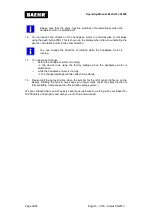
Operating Manual BaehrTec S1200
Page 30/48
English – V100 – Status 09/2015
deposits on the fine spray lines. This would destroy the pump
(no
guarantee on all spray-related units and components).
On no account should you use emulsions of creams you have mixed
yourself for the spray function since these could damage the spray
function and the guarantee will no longer apply.
Please only use spray liquids that have been approved for the spray
device.
2.
Please ensure that the device has a secure footing, does not fall down and cannot be
torn down, and that the extracted air can escape easily. Please never cover the
ventilation holes. Switch the main switch
(3)
off.
3.
Connect the supplied non-heating connection cable
(53)
with the non-heating
connector
(52)
to the plug
(33).
4.
Plug the safety plug to
(54)
in a proper safety outlet.
5.
Now switch the BaehrTec S1200 on using the main switch
(2)
. After a short LED
check, the LED "Power ON"
(4)
and the LED for the largest instrument (6,000 rpm.)
will light up
(5a)
.
The following things are set after each power on:
o
Handpiece motor direction of rotation = right
o
Handpiece speed = 6,000 rpm (LED illuminated)
o
Handpiece motor = OFF
o
Spray level = 0
o
Spray = OFF
These settings will also be shown to you accordingly on the display. The BaehrTec
S1200 is now ready for use.
6.
Take the handpiece in one hand and insert an instrument with a shank diameter 2.35
mm as deep as possible into the opening DIN instruments
(51)
. The head of the
instrument must not be larger than that shown on the front panel (max. 12 mm).
Never use instruments with an oily, worn or bent shaft. Otherwise, it cannot
be guaranteed that your instrument can be held firmly in the handpiece!
Caution – risk of injury! Never
attempt to insert or remove instruments
into/ out of the opening
(51)
when the handpiece motor is running.
Instruments can only be changed when the handpiece motor is switched off.
The instrument heads indicated on the front foil are intended to help you
identify the maximum speed for your instruments. However, before you work
with an instrument, be sure to follow the manufacturer’s instructions on the
permitted maximum speed. The maximum speed specified there must not
be exceeded under any circumstances. This poses a danger of injury and
the danger that your device will be damaged.
7.
Now select the permitted maximum speed for the instrument you currently want to
work with. The instrument heads depicted (max. diameter) and the associated speed
should help you to quickly and safely find the permitted maximum speed for your
instruments.
The permitted maximum speed must not be exceeded under any
circumstances
; otherwise the instrument or the handpiece may be damaged. It can
also cause injury due to broken instrument heads. You can find out the correct
permissible maximum speed for the instrument that you are using by comparing the
instrument head diameter with the instrument heads shown on the front foil. Once you
have found a match, press the illustrated instrument head that you have found to be
correct. The permitted
maximum
speed is now set. The speed is shown in the display.
Lower speeds are generally permitted for all of the instruments.
WARNING: This is a speed recommendation. Please refer to the data sheet of the
instrument manufacturer to find out the permitted maximum speed of the instrument.
The permitted maximum speed must not be exceeded under any circumstances;






























